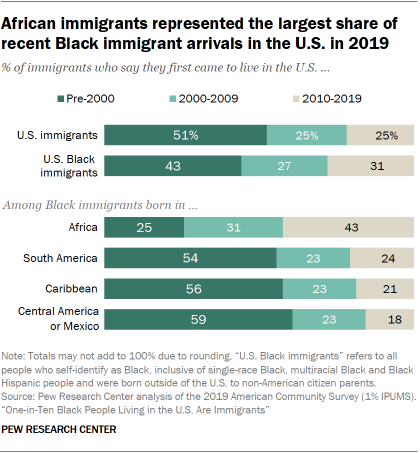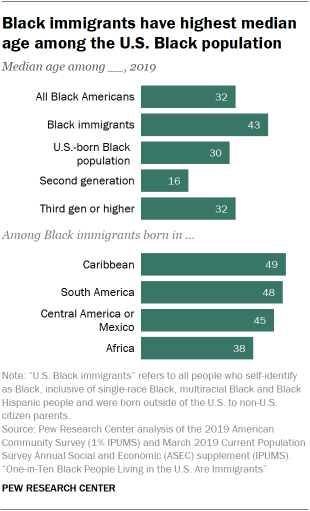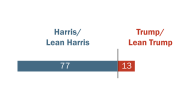Almost six-in-ten Black foreign-born people living in the United States (58%) immigrated to the U.S. in 2000 or later, according to a Pew Research Center analysis of the 2019 American Community Survey. Roughly three-in-ten (31%) immigrated to the U.S. between 2010 and 2019, and a little over a quarter (27%) immigrated to the country from 2000 to 2009. By contrast, half of U.S. immigrants overall have immigrated to the country since 2o00, with 25% having immigrated from 2000 to 2009 and another quarter immigrating from 2010 to 2019.
Among Black immigrants, year of immigration differs by region of birth. Black immigrants born in the Caribbean, Central America or Mexico, or South America have, on average, come to the U.S. earlier than their African-born counterparts.
African-born Black immigrants stand out for the recentness of their arrival in the U.S. Three-quarters arrived in the country in 2000 or later, with over four-in-ten (43%) having arrived from 2010 to 2019 alone. Fewer than two-in-ten (16%) arrived between 1990 and 1999, and just 10% arrived in the U.S. prior to 1980. By contrast, fewer than half of those born in the Caribbean, Central America or Mexico, or South America (44%, 41% and 46%, respectively) arrived in the U.S. in 2000 or later, meaning that over half of Black immigrants born in these regions arrived in the U.S. before the turn of the 21st century.
Half of the Black immigrant population is age 43 or older
The age structure of the U.S. Black immigrant population has changed since 2000, when the median age was 37, compared with 42 in 2019.
The Black foreign-born population is older than its U.S.-born counterpart. While the median age of the Black immigrant population was 42 in 2019, that of the U.S.-born Black population was 30.
Median ages vary among different generations. Second-generation Black Americans have a median age of 16, making them the youngest generation included in this analysis. Black Americans of third and higher generations have a median age of 32, making this segment of the population younger than Black immigrants.
Age differs among different parts of the Black foreign-born population as well. When it comes to region of origin, the Caribbean-born population has the highest median age, at 49. Black immigrants born in South America have a median age of 48. Those born in Central America or Mexico had a median age of 45, while African-born immigrants had the lowest median age at 38.
Majority of Black immigrants live in family households
An 80% majority of the Black immigrant population lived in family households in 2019. Overall, just over half (54%) of Black immigrants lived in a household headed by a married couple, while 19% lived in a female-headed household and just 7% lived in a male-headed household.
There are differences among the Black foreign-born population by region of birth. While roughly half or more from the major regions lived in a household headed by a married couple in 2019, the African-born population stands out for having the largest share (58%) who lived in this type of household. Just over half of South American-born immigrants lived in a married-couple household (53%), while roughly half of both Black immigrants born in Central America or Mexico (48%) and those from the Caribbean (50%) lived in a similar household arrangement.
The Black immigrant population differs from the overall U.S. immigrant and U.S.-born Black populations on this measure. Close to two-thirds (65%) of U.S. immigrants lived in a married-couple household in 2019, which is the highest share among population groups included in this analysis. Meanwhile, a six-in-ten majority of the U.S. population lived in a married-couple household as well, while 36% of the U.S.-born Black population lived in this household type.







